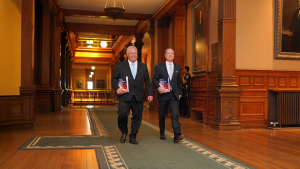The below-average temperatures that have characterized much of this winter have significantly driven up the costs of construction at projects in southwestern Ontario.
The below-average temperatures that have characterized much of this winter have significantly driven up the costs of construction at projects in southwestern Ontario.
And although we’ve probably seen the last of extended cold periods, be prepared for it to return in shorter stints over the next few weeks.
Derek Smith, executive director of the London and District Construction Association says that seven firms of $5-$50 million in revenue and working mostly on commercial and institutional projects report cost increases of 30 to 40 per cent above normal allowances for this time of year.
Two thirds of these members also report severe delays ranging from three to five weeks because of weather with the remainder reporting delays of two to three weeks.
“I don’t know anybody that can carry that kind of an increase in winter costs,” says Smith.
Glenn Finnie, of Finnbilt General Contracting Ltd., based in Stratford, says the cold weather has added costs to three projects his company is completing over the winter months. These include a $1.8 million combination water reservoir and booster pumping stations near Seaforth, a $4.4 million water treatment plant generator upgrade in Elgin County and a sewage expansion in Kilworth, north of London.
“This has been a harsher winter than what we’ve seen in the last five years,” says Finnie, who attributes the extra costs to hording and heating as well as loss of productivity.
“It has cost us more to stay on schedule.” He would not estimate how much weather-related expenses have added to project costs.
But one thing’s for sure: his business will be absorbing the added expense. “We’re big boys. We live in the snowbelt.”
He says he always estimates what he expects his winter costs are going to be. “Some years they’re less than maybe what you’d expect and some years they’re more.”
Terry Elligson, a regional sales manager with Blyth-based Sparling’s Propane, which supplies fuel for construction site heating units, says demand for fuel has started earlier this season and lasted longer but there hasn’t been a large increase in the volume used.
David Phillips, senior climatologist with Environment Canada says the London area has already received its full year’s allotment of snow — and there are still several weeks of winter left to go. On top of that, November and December were slightly cooler than normal and January was “relentlessly cold,” he says, noting the month’s temperatures were three to 3.5 degrees colder than its normal temperature and seven degrees colder than it was last winter.
“Some have characterized it as a brutal winter; I’m not sure it goes back to the ’70s when we had really cold and snowy winters but this is one that’s been in many ways more fierce than last year,” he says.
Although it’s possible the groundhogs are wrong and we’ve seen the last of winter temperatures, Phillips predicts colder temperatures will return in shorter stints over the next few weeks broken up by warmer temperatures.










Recent Comments
comments for this post are closed